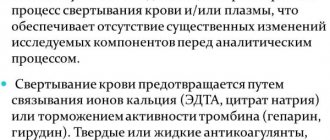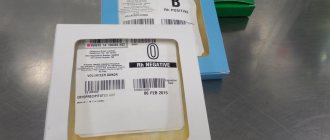Composition and release form
| Injection | 1 amp. |
| sulodexide | 600 LE |
| excipients: sodium chloride - 18 mg; water for preparing injections - qs up to 2 ml |
in ampoules of 2 ml; There are 10 ampoules in a box.
| Capsules | 1 caps. |
| sulodexide | 250 LE |
| excipients: sodium lauryl sulfate - 3.3 mg; silicon dioxide colloid - 3.0 mg; triglycerides - 86.1 mg | |
| capsule composition: gelatin - 55.0 mg; glycerin - 21.0 mg; sodium ethyl p-hydroxybenzoate - 0.24 mg; sodium propyl paraoxybenzoate - 0.12 mg; titanium dioxide (E171) - 0.30 mg; red iron oxide - 0.90 mg |
25 pcs in blister; There are 2 blisters in a box.
Pharmacodynamics
The fast-flowing heparin-like fraction has an affinity for antithrombin III, and the dermatan fraction has an affinity for heparin cofactor II. The anticoagulant effect is due to the affinity for heparin cofactor II, which inactivates thrombin.
The mechanism of antithrombotic action is associated with the suppression of activated factor X, with increased synthesis and secretion of prostacyclin (PGI2), with a decrease in the level of fibrinogen in the blood plasma, etc.
The profibrinolytic effect is due to an increase in the blood level of tissue plasminogen activator and a decrease in the content of its inhibitor.
The angioprotective effect is associated with the restoration of the structural and functional integrity of vascular endothelial cells, with the restoration of the normal density of the negative electrical charge of the pores of the vascular basement membrane. In addition, the drug normalizes the rheological properties of the blood by reducing the level of triglycerides (stimulates the lipolytic enzyme - lipoprotein lipase, which hydrolyzes triglycerides that are part of LDL).
Reduces blood viscosity, inhibits the proliferation of mesangial cells, and reduces the thickness of the basement membrane.
Composition and release form
Active substance: sulodexide 250LE
Excipients: sodium lauryl sulfate - 3.3 mg; silicon dioxide colloid - 3.0 mg; triglycerides - 86.1 mg
Capsule composition: gelatin - 55.0 mg; glycerin - 21.0 mg; sodium ethyl p-hydroxybenzoate - 0.24 mg; sodium propyl paraoxybenzoate - 0.12 mg; titanium dioxide (E171) - 0.30 mg; red iron oxide - 0.90 mg
25 pcs in blister; There are 2 blisters in a box.
Description of the dosage form
Solution for injection: light yellow or yellow transparent solution placed in dark transparent glass ampoules.
Capsules: oval-shaped soft gelatin capsules, brick red in color.
Characteristic
A natural product isolated from the mucous membrane of the small intestine of pigs. It is a natural mixture of glycosaminoglycans: heparin-like fraction with a molecular weight of 8,000 daltons (80%) and dermatan sulfate (20%).
pharmachologic effect
Pharmacological action - profibrinolytic, antithrombotic, anticoagulant, angioprotective.
Pharmacodynamics
The fast-flowing heparin-like fraction has an affinity for antithrombin III, and the dermatan fraction has an affinity for heparin cofactor II. The anticoagulant effect is due to the affinity for heparin cofactor II, which inactivates thrombin.
The mechanism of antithrombotic action is associated with the suppression of activated factor X, with increased synthesis and secretion of prostacyclin (PGI2), with a decrease in the level of fibrinogen in the blood plasma, etc.
The profibrinolytic effect is due to an increase in the blood level of tissue plasminogen activator and a decrease in the content of its inhibitor.
The angioprotective effect is associated with the restoration of the structural and functional integrity of vascular endothelial cells, with the restoration of the normal density of the negative electrical charge of the pores of the vascular basement membrane. In addition, the drug normalizes the rheological properties of the blood by reducing the level of triglycerides (stimulates the lipolytic enzyme - lipoprotein lipase, which hydrolyzes triglycerides that are part of LDL).
Reduces blood viscosity, inhibits the proliferation of mesangial cells, and reduces the thickness of the basement membrane.
Pharmacokinetics
90% is absorbed in the vascular endothelium (creating a concentration in it that is 20–30 times higher than its concentration in the tissues of other organs) and is absorbed in the small intestine. Metabolized in the liver and kidneys. Unlike unfractionated heparin and low molecular weight heparins, sulodexide is not subject to desulfation, which leads to a decrease in antithrombotic activity and significantly accelerates elimination from the body. Dose distribution across organs showed that the drug undergoes extracellular diffusion in the liver and kidneys 4 hours after administration.
24 hours after intravenous administration, urinary excretion is 50% of the drug, and after 48 hours - 67%.
Indications for the drug Wessel Due F
angiopathy with an increased risk of thrombosis, incl. after myocardial infarction;
cerebrovascular accidents, including the acute period of ischemic stroke and the period of early recovery;
discirculatory encephalopathy caused by atherosclerosis, diabetes mellitus, hypertension;
vascular dementia;
occlusive lesions of peripheral arteries of atherosclerotic and diabetic origin;
phlebopathy, deep vein thrombosis;
microangiopathy (nephropathy, retinopathy, neuropathy) and macroangiopathy (diabetic foot syndrome, encephalopathy, cardiopathy) in diabetes mellitus;
thrombophilic conditions, antiphospholipid syndrome (together with acetylsalicylic acid, as well as following low molecular weight heparins);
Treatment of heparin-induced thrombotic thrombocytopenia (HTT), since the drug does not cause or worsen HTT.
Contraindications
hypersensitivity;
hemorrhagic diathesis and diseases accompanied by decreased blood clotting;
pregnancy (first trimester).
Use during pregnancy and breastfeeding
During pregnancy, it is prescribed under the strict supervision of a doctor. There is positive experience of use for the treatment and prevention of vascular complications in patients with type 1 diabetes in the II and III trimesters of pregnancy, with the development of late toxicosis of pregnancy - gestosis.
Side effects
From the gastrointestinal tract: nausea, vomiting, epigastric pain.
Allergic reactions: rash.
Other: pain, burning, hematoma at the injection site.
Interaction
Simultaneous use with drugs that affect the hemostatic system (direct and indirect anticoagulants, antiplatelet agents) is not recommended.
Directions for use and doses
IM, IV (in 150–200 ml of saline), orally. At the beginning of treatment, administer the contents of 1 ampoule daily intramuscularly for 15–20 days, then 1 caps. 2 times a day orally between meals for 30–40 days. The full course should be repeated at least 2 times a year. At the discretion of the doctor, the dosage regimen may be changed.
Overdose
Symptoms: Bleeding or bleeding.
Treatment: drug withdrawal, symptomatic therapy.
special instructions
If necessary, it is recommended to use the drug under the control of a coagulogram. At the beginning and end of treatment, it is advisable to determine the following indicators: aPTT (normally - 30–40 s, depending on the type and concentration of the activator used, it can be 25–30 or 35–50 s), antithrombin III content (normally - 210–300 mg/l), bleeding time (normal according to Duques - 2-4 minutes), clotting time of unstabilized blood (normal according to the Milian method as modified by Morawitz - 6-8 minutes). Wessel Due F increases normal values by approximately one and a half times.
A comment
Wessel Due F, capsules - packaging Pharmakor Production (Russia).
Wessel Due F, ampoules - packaging Pharmakor Production (Russia).
Storage conditions for the drug Wessel Due F
- At a temperature not exceeding 30 °C.
- Keep out of the reach of children.
Shelf life of the drug Wessel Due F
- 5 years.
- Do not use after the expiration date stated on the package.
Pharmacokinetics
90% is absorbed in the vascular endothelium (creating a concentration in it that is 20–30 times higher than its concentration in the tissues of other organs) and is absorbed in the small intestine. Metabolized in the liver and kidneys. Unlike unfractionated heparin and low molecular weight heparins, sulodexide is not subject to desulfation, which leads to a decrease in antithrombotic activity and significantly accelerates elimination from the body. Dose distribution across organs showed that the drug undergoes extracellular diffusion in the liver and kidneys 4 hours after administration.
24 hours after intravenous administration, urinary excretion is 50% of the drug, and after 48 hours - 67%.
Wessel Due F solution d/inf. 600LE 2ml N 10
Description of the dosage form
Solution for injection: light yellow or yellow transparent solution placed in dark transparent glass ampoules.
Capsules: oval-shaped soft gelatin capsules, brick red in color.
Pharmacodynamics
The fast-flowing heparin-like fraction has an affinity for antithrombin III, and the dermatan fraction has an affinity for heparin cofactor II. The anticoagulant effect is due to the affinity for heparin cofactor II, which inactivates thrombin.
The mechanism of antithrombotic action is associated with the suppression of activated factor X, with increased synthesis and secretion of prostacyclin (PGI2), with a decrease in the level of fibrinogen in the blood plasma, etc.
The profibrinolytic effect is due to an increase in the blood level of tissue plasminogen activator and a decrease in the content of its inhibitor.
The angioprotective effect is associated with the restoration of the structural and functional integrity of vascular endothelial cells, with the restoration of the normal density of the negative electrical charge of the pores of the vascular basement membrane. In addition, the drug normalizes the rheological properties of the blood by reducing the level of triglycerides (stimulates the lipolytic enzyme - lipoprotein lipase, which hydrolyzes triglycerides that are part of LDL).
Reduces blood viscosity, inhibits the proliferation of mesangial cells, and reduces the thickness of the basement membrane.
Pharmacokinetics
90% is absorbed in the vascular endothelium (creating a concentration in it that is 20–30 times higher than its concentration in the tissues of other organs) and is absorbed in the small intestine. Metabolized in the liver and kidneys. Unlike unfractionated heparin and low molecular weight heparins, sulodexide is not subject to desulfation, which leads to a decrease in antithrombotic activity and significantly accelerates elimination from the body. Dose distribution across organs showed that the drug undergoes extracellular diffusion in the liver and kidneys 4 hours after administration.
24 hours after intravenous administration, urinary excretion is 50% of the drug, and after 48 hours - 67%.
Wessel Due F: Indications
angiopathy with an increased risk of thrombosis, incl. after myocardial infarction;
cerebrovascular accidents, including the acute period of ischemic stroke and the period of early recovery;
discirculatory encephalopathy caused by atherosclerosis, diabetes mellitus, hypertension;
vascular dementia;
occlusive lesions of peripheral arteries of atherosclerotic and diabetic origin;
phlebopathy, deep vein thrombosis;
microangiopathy (nephropathy, retinopathy, neuropathy) and macroangiopathy (diabetic foot syndrome, encephalopathy, cardiopathy) in diabetes mellitus;
thrombophilic conditions, antiphospholipid syndrome (together with acetylsalicylic acid, as well as following low molecular weight heparins);
Treatment of heparin-induced thrombotic thrombocytopenia (HTT), since the drug does not cause or worsen HTT.
Wessel Due F: Contraindications
hypersensitivity;
hemorrhagic diathesis and diseases accompanied by decreased blood clotting;
pregnancy (first trimester).
Use during pregnancy and breastfeeding
During pregnancy, it is prescribed under the strict supervision of a doctor. There is positive experience of use for the treatment and prevention of vascular complications in patients with type 1 diabetes in the II and III trimesters of pregnancy, with the development of late toxicosis of pregnancy - gestosis.
Directions for use and doses
IM, IV (in 150–200 ml of saline), orally. At the beginning of treatment, the contents of 1 ampoule are administered intramuscularly daily for 15–20 days, then 1 caps. 2 times a day orally between meals for 30–40 days. The full course should be repeated at least 2 times a year. At the discretion of the doctor, the dosage regimen may be changed.
Wessel Due F: Side effects
From the gastrointestinal tract: nausea, vomiting, epigastric pain.
Allergic reactions: rash.
Other: pain, burning, hematoma at the injection site.
Overdose
Symptoms: Bleeding or bleeding.
Treatment: drug withdrawal, symptomatic therapy.
Interaction
Simultaneous use with drugs that affect the hemostatic system (direct and indirect anticoagulants, antiplatelet agents) is not recommended.
special instructions
If necessary, it is recommended to use the drug under the control of a coagulogram. At the beginning and end of treatment, it is advisable to determine the following indicators: aPTT (normally - 30–40 s, depending on the type and concentration of the activator used, it can be 25–30 or 35–50 s), antithrombin III content (normally - 210–300 mg/l), bleeding time (normal according to Duques - 2-4 minutes), clotting time of unstabilized blood (normal according to the Milian method as modified by Morawitz - 6-8 minutes). Wessel Due F increases normal values by approximately one and a half times.
Characteristic
A natural product isolated from the mucous membrane of the small intestine of pigs. It is a natural mixture of glycosaminoglycans: heparin-like fraction with a molecular weight of 8,000 daltons (80%) and dermatan sulfate (20%).
Indications for the drug Wessel Due F
angiopathy with an increased risk of thrombosis, incl. after myocardial infarction;
cerebrovascular accidents, including the acute period of ischemic stroke and the period of early recovery;
discirculatory encephalopathy caused by atherosclerosis, diabetes mellitus, hypertension;
vascular dementia;
occlusive lesions of peripheral arteries of atherosclerotic and diabetic origin;
phlebopathy, deep vein thrombosis;
microangiopathy (nephropathy, retinopathy, neuropathy) and macroangiopathy (diabetic foot syndrome, encephalopathy, cardiopathy) in diabetes mellitus;
thrombophilic conditions, antiphospholipid syndrome (together with acetylsalicylic acid, as well as following low molecular weight heparins);
Treatment of heparin-induced thrombotic thrombocytopenia (HTT), since the drug does not cause or worsen HTT.
Wessel Due 600 instructions for use
Indications for use
The medication is intended for people with the following health problems:
- Angiopathy (problems with blood vessels due to a disorder of nervous regulation), including thrombosis caused by myocardial infarction.
- Macroangiopathy caused by diabetes mellitus.
- Different types of microangiopathy (retinopathy, nephropathy, neuropathy).
- Thrombosis, phlebopathy (deep vein diseases).
- Heparin-induced thrombocytopenia (HIT).
- Disturbances in the blood coagulation system that provoke thrombosis (thrombophilia).
- APS (antiphospholipid syndrome).
- Vascular encephalopathies.
- DFS (diabetic foot syndrome).
In addition, it is effective for vascular diseases of the brain caused by pathology in the cerebral vessels, which has led to a deterioration in cerebral circulation:
- stroke (including rehabilitation);
- DEP (dyscirculatory encephalopathy) due to high blood pressure, diabetes mellitus or atherosclerosis;
- vascular dementia.
Vessel Due F treats narrowing and blockage of the arteries of the legs or arms of diabetic, as well as atherosclerotic origin.
Important! In Russia, such medicine is available only by prescription, so self-treatment is fraught with serious problems - do not neglect consulting a specialist!
pharmachologic effect
Sulodexide is a complex of glycosaminoglycans obtained from natural raw materials (pork intestinal mucosa extract). It promotes thrombin inhibition and thereby prevents the formation of blood clots.
By choosing Wessel Due 600 ampoules you will receive an effective medication with the following properties:
- antithrombic;
- anticoagulant;
- fibrinolytic;
- angioprotective;
- anti-adhesive;
- angioprotective.
The active substance is absorbed by the walls of the small intestine, after which approximately 90% of the drug accumulates in the inner walls of blood vessels (endothelium). The metabolic process takes place in the liver. Excreted from the body with urine (kidneys).
How to take, course of administration and dosage
Important! Doses and duration of use directly depend on the specifics of the problem. Therefore, all recommendations on these parameters should be prescribed ONLY by the attending physician! In addition, in some cases, treatment with Wessel Due 600 ampoules is supplemented with Wessel Due capsules.
Here are a number of GENERAL recommendations from the manufacturer:
Angiopathy leading to thrombosis
1 ampoule per day IM. Duration – month. Then they start taking capsules.
Acute ischemic stroke
The liquid from 1 ampoule is pre-diluted in 150-200 ml of NaCl and administered intravenously over 60-120 minutes. Dosage – 600 LE per day. Duration – from 15 to 20 days. Then capsules.
Narrowing and blockage of arteries
1 ampoule intramuscularly for 20-30 days in a row. Then capsules.
Deep vein diseases
1 ampoule IM per day for 10-30 days.
Macroangiopathies and microangiopathies
1 ampoule per day for 15 days in a row. Then they switch to capsules.
GIT
One ampoule is mixed with 20 ml of NaCl (0.9%) and administered intravenously over 5 minutes. Then another ampoule is diluted in 100 ml of NaCl and administered over an hour. Frequency – 2 times a day at equal intervals.
Note! Before starting treatment and after its completion, it is necessary to conduct laboratory tests for a number of indicators, such as the duration of bleeding and the duration of blood clotting, the level of antithrombin III and some others. In addition, hemocoagulation parameters are monitored throughout the course of treatment.
Contraindications
Individual intolerance to one of the substances included in the drug. Diseases associated with decreased blood clotting (for example, hemorrhagic diathesis). The drug should not be used by nursing women, since it is not clear whether sulodexide can pass into breast milk. It is STRICTLY prohibited to prescribe it to children under 12 years of age.
Side effects
Due to violation of the dosage and course of treatment, hemorrhagic syndrome or bleeding is possible. In the latter case, a heparin antagonist (for example, protamine sulfate) is administered. In case of an overdose in general, stop using the medicine and immediately consult a doctor for appropriate therapy.
Other side effects include:
- Dizziness (often), headache and extremely rarely – fainting;
- Abdominal pain (upper part), intestinal upset, bloating, nausea, vomiting;
- Rash, redness, eczema, hives;
- Chest pain, discomfort at the injection site, hematoma.
Pregnant women in the first trimester are prescribed a medicine only if the benefit from it is greater than the risk to the fetus. In the second and third trimesters, treatment is carried out ONLY under the supervision of a doctor.
Special instructions
A must read! Combination with other drugs.
During treatment, the doctor may prescribe extemporaneous combinations. This solution contains several drugs. Therefore, before you buy Wessel Due 600, make sure that it is not planned to be used simultaneously with:
- B vitamins;
- vitamin K;
- calcium gluconate;
- tetracycline;
- streptomycin;
- hydrocortisone;
- quaternary ammonium salts;
- hyaluronidase.
When used simultaneously with medications (including oral medications) containing heparin or heparin-like substances, the anticoagulant effect will be greater.
Storage conditions
Store in a place protected from sunlight, away from children.
special instructions
If necessary, it is recommended to use the drug under the control of a coagulogram. At the beginning and end of treatment, it is advisable to determine the following indicators: aPTT (normally - 30–40 s, depending on the type and concentration of the activator used, it can be 25–30 or 35–50 s), antithrombin III content (normally - 210–300 mg/l), bleeding time (normal according to Duques - 2-4 minutes), clotting time of unstabilized blood (normal according to the Milian method as modified by Morawitz - 6-8 minutes). Wessel Due F increases normal values by approximately one and a half times.






